Themed collection Marine-based Green Chemistry

Marine-based green chemistry
Guest editors, Robin D. Rogers and Francesca M. Kerton introduce this themed issue on marine-based green chemistry.

Green Chem., 2022,24, 2265-2266
https://doi.org/10.1039/D2GC90018A
From green to blue economy: Marine biorefineries for a sustainable ocean-based economy
Biorefinery is the ideal model to help marine industries to apply green and blue economy principles towards a more sustainable, profitable, and conscious ocean economy.
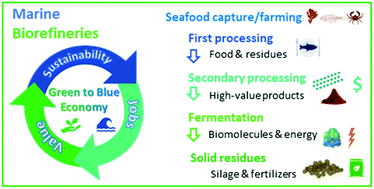
Green Chem., 2021,23, 9377-9400
https://doi.org/10.1039/D1GC03191K
Recent progress on immobilization technology in enzymatic conversion of marine by-products to concentrated omega-3 fatty acids
A comprehensive summary of recent research progress applying immobilization technology in sustainable development of marine biomass to value-added products.

Green Chem., 2022,24, 1049-1066
https://doi.org/10.1039/D1GC03127A
Production of chemicals from marine biomass catalysed by acidic ionic liquids
Conversions of chitosan, chitin, and crustacean shells to high value-added chemicals using acidic ionic liquids (ILs) as catalysts have been reviewed, demonstrating the structural effect of marine biomass on their conversion.
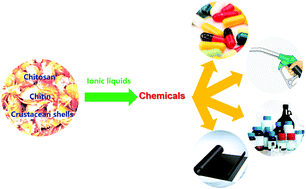
Green Chem., 2021,23, 9800-9814
https://doi.org/10.1039/D1GC03249F
Neoteric solvent-based blue biorefinery: for chemicals, functional materials and fuels from oceanic biomass
Chemicals, materials and fuels from oceanic biomass using new types of solvent systems, facilitating sustainable and eco-friendly blue-biorefineries.
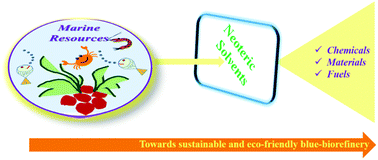
Green Chem., 2021,23, 8821-8847
https://doi.org/10.1039/D1GC03184H
Progresses and future prospects in biodegradation of marine biopolymers and emerging biopolymer-based materials for sustainable marine ecosystems
With approximately 250 000 marine species, the ocean is a vast reservoir of biodiversity and an abundant biological resource of natural polymers and microorganisms producing biopolymer-degrading enzymes.
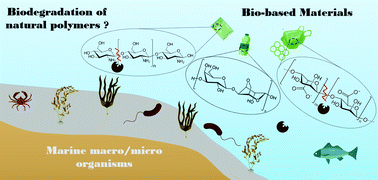
Green Chem., 2022,24, 1762-1779
https://doi.org/10.1039/D1GC04327G
Applications of deep eutectic solvents in the extraction, dissolution, and functional materials of chitin: research progress and prospects
Deep eutectic solvents (DESs) as sustainable solvents for chitin extraction, dissolution, and functional materials.

Green Chem., 2022,24, 552-564
https://doi.org/10.1039/D1GC04340D
Progress in marine derived renewable functional materials and biochar for sustainable water purification
This review sheds light on various marine-based sustainble resources used to develop high-performance materials for water purification technologies.
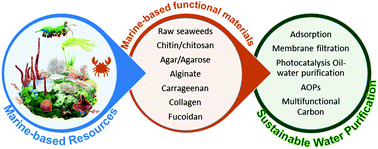
Green Chem., 2021,23, 8305-8331
https://doi.org/10.1039/D1GC03054J
Influence of storage temperature on the stability of heat treated phycocyanin-λ-carrageenan complexes in liquid formulations
The protein-chromophore interactions of phycocyanin are prone to changes in environmental conditions. Loss of these interactions leads to disappearance of the color. After stabilization with λ-carrageenan, phycocyanin can be stabilized over 28 days.

Green Chem., 2022,24, 4174-4185
https://doi.org/10.1039/D2GC00809B
Synergistic complexation of phenol functionalized polymer induced in situ microfiber formation for 3D printing of marine-based hydrogels
This study proposes a strategy to design tough and 3D printable marine-based hydrogels based on the synergistic complexation of a phenolated polyelectrolyte complex and enzyme-mediated crosslinking.
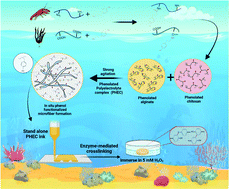
Green Chem., 2022,24, 2409-2422
https://doi.org/10.1039/D1GC04347A
Two-step demineralization of shrimp (Pandalus Borealis) shells using citric acid: an environmentally friendly, safe and cost-effective alternative to the traditional approach
An environmentally friendly and economically viable process for demineralization of shrimp shells for production of high-quality chitin and chitosan.
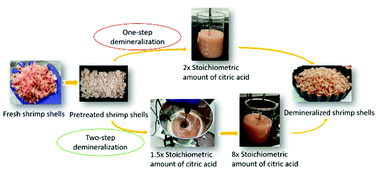
Green Chem., 2022,24, 1141-1151
https://doi.org/10.1039/D1GC03140F
Choosing the right strategy: cryogrinding vs. ball milling – comparing apples to apples
Despite many reports on ball milling (BM) of chitin, the effect of cryomilling of chitin has not yet been reported, even though it is a solventless and environmentally-friendly method for the processing of chitin polymer.

Green Chem., 2021,23, 9646-9657
https://doi.org/10.1039/D1GC03128G
Uncovering the potential of aqueous solutions of deep eutectic solvents on the extraction and purification of collagen type I from Atlantic codfish (Gadus morhua)
Deep eutectic solvents as efficient solvents to extract and purify collagen from codfish skins.
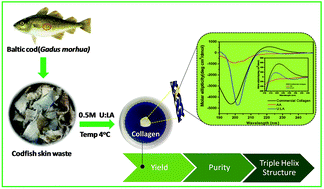
Green Chem., 2021,23, 8940-8948
https://doi.org/10.1039/D1GC01432C
Innovative methodology for marine collagen–chitosan–fucoidan hydrogels production, tailoring rheological properties towards biomedical application
This study provides a deeper understanding of the relationships between marine biopolymer structure/composition and rheological mechanical properties in ionic-linked hydrogel network-based formulations as a sustainable process for tissue engineering.
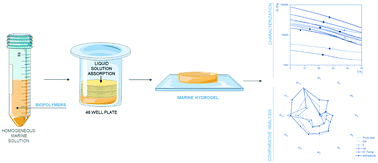
Green Chem., 2021,23, 7016-7029
https://doi.org/10.1039/D1GC02223G
Evaluation of sustainable technologies for the processing of Sargassum muticum: cascade biorefinery schemes
Cascade biorefinery schemes using sustainable technologies were proposed for a complete valorization of the invasive macroalgae Sargassum muticum.
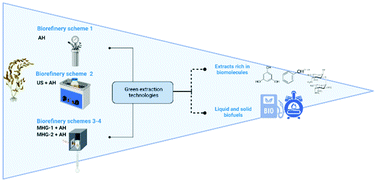
Green Chem., 2021,23, 7001-7015
https://doi.org/10.1039/D1GC01900G
Chitosan nanocrystals synthesis via aging and application towards alginate hydrogels for sustainable drug release
Marine biomass waste is a remarkable source of functional molecules and materials.

Green Chem., 2021,23, 6527-6537
https://doi.org/10.1039/D1GC01611C
About this collection
Sustainability is the color of Cyan: from the terrestrial green to the marine blue, our planet’s finite resources must be not only preserved, but utilized in a sustainable way. We live on a blue planet with over two thirds of the surface covered in water. The oceans have the potential to provide resources, such as food, biopolymers to replace plastics, and minerals to replace mining, but this environment is also under threat from plastic, pollution, and CO2 levels. This themed collection of Green Chemistry is dedicated to the sustainable development of ocean resources at the interface of green technology and the blue economy. Chemistry has a major role to play in both utilizing and protecting the oceans and thus, we explore how Green Chemistry is tackling the dual challenges the oceans represent.